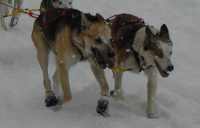What Dr Arleigh Reynolds D.V.M. has to say about the Champaine meat.

I first met Charlie Champaine in 1990 when he was at the pinnacle of his sled dog racing career. At that time he completely dominated the sprint racing arena. As an athlete, an exercise physiologist, and a nutritionist I was curious to learn how someone with a relatively small kennel was consistently able to stay on top of one of the most highly competitive fields in the sporting world. It quickly became apparent to me that Charlie excelled in one quality that led to his dominance on the trail - a meticulous attention to detail.
Nowhere was this trait more evident than in the level of care he provided to his dogs. Early in Charlie's racing career he realized that the unique needs of these unparalleled athletes could not be met by any of the commercial diets available at the time. Rather than settle for what was available Charlie took it upon himself to develop a diet that would support the maximum efforts of his elite dog team. Starting with a diet based on his years of mushing experience, he constantly evaluated his dogs response and refined the formula until he achieved what is now called the "Champaine Race Diet."
I have been studying the relationship between diet and performance in sled dogs for over 10 years in my laboratory and on the Alaskan sled dog trails. During that time I have learned a great deal about the role played by protein and fat in supporting maximal performance in working dogs. Briefly, we have found that high intakes of protein support maximal oxygen metabolism, blood volume, red blood cell mass, and may help prevent injuries. Enhanced fat intake also supports maximal oxygen utilization and provides the canine muscle with it's most preferred fuel, thus promoting stamina. 
When Charlie first asked me to evaluate his race diet I was amazed how closely his diet fit the parameters we had determined through our experiments. Through his experience and fine tuning he had reached exactly the same conclusions we had in our laboratory. As he became a force in the sled dog racing world his competitors and friends realized how much this diet contributed to his success and urged him to make it available to others. The legendary attention to detail which was unbeatable on the dog trail has proven to be an asset in the manufacturing of dog food as well. Champaine Race Diet has been the foundation of the diets fed to all of the most recent Champions of the Iditarod, Yukon Quest and Rocky Mountain Stage Stop Races.
Like most successful competitors, Charlie has sought to consistently improve his products as new requirements are recognized among his patrons. With the addition of a new line of freeze dried products his company is once again leading the way in premium performance dog food. This new line offers all the benefits of the traditional frozen diet with several additional advantages. These diets are light weight and non-perishable, and therefore, are easy to transport, store and use. The freeze drying process allows preservation of all the nutrients found naturally in the ingredients used without altering them or making them less available as can occur in more traditional means of preservation such as chemical or heat treatment.
 An additional benefit of making these diets in a freeze-dried form has been an unexpected and remarkable enhancement in their palatability. Whether it is the texture or an increased retention of aromatic compounds these diets have proven invaluable in coaxing tired racing dogs or convalescent canine patients to eat. It is no wonder that the 1998 Champions of both the Iditarod Trail Race and The Yukon Quest (both 1,000 mile races) attributed much of their success to the advantages gained by feeding freeze dried Champaine Race Diet. Safety from spoilage, lighter sleds, and enhanced ease of feeding and palatability were all cited by both champions as major advantages conveyed by these diets.
An additional benefit of making these diets in a freeze-dried form has been an unexpected and remarkable enhancement in their palatability. Whether it is the texture or an increased retention of aromatic compounds these diets have proven invaluable in coaxing tired racing dogs or convalescent canine patients to eat. It is no wonder that the 1998 Champions of both the Iditarod Trail Race and The Yukon Quest (both 1,000 mile races) attributed much of their success to the advantages gained by feeding freeze dried Champaine Race Diet. Safety from spoilage, lighter sleds, and enhanced ease of feeding and palatability were all cited by both champions as major advantages conveyed by these diets.
Although few people will ever have the opportunity to use these diets on elite sled dog teams, the advantages enjoyed by these sled dogs are now available for the first time to other canine athletes. Our research has demonstrated that the advantages of high fat, high protein diets are realized in hard working dogs other than sled dogs and yet few of these other canine athletes have traditionally had access to these diets. The recent production of Champaine Race Diet in a freeze dried form should revolutionize nutrition for every type of working dog. This diet will benefit the jogging companion, the backpacker, the field trial and hunting dog, the service dog, and any dog experiencing physical or mental stress.* As a veterinary nutritionist, I have found this diet to be a valuable asset in the treatment of stressed hospitalized patients. It's caloric density and distribution of nutrients along with it's superb palatability make it an ideal diet for encouraging convalescent patients to eat.
This diet has revolutionized the way that racing sled dogs are fed and I feel confident that it will have a similar effect on all other arenas of the working dog world. Such an advancement in the welfare of these magnificent athletes deserves recognition and praise.
Arleigh J. Reynolds, DVM, PhD,
Diplomate, American College of Veterinary Nutrition
* There are certain breeds of dogs (such as Miniature Schnauzers) and certain disease conditions (such as hyperlipidemia) where this diet may be contraindicated. If you are unsure about the health status of your dog consult your veterinarian before engaging your dog in any change of diet or exercise patterns.
Diplomate, American College of Veterinary Nutrition